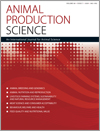
Animal Production Science
Volume 60 Number 7 2020
AN19344Management of phosphorus nutrition of beef cattle grazing seasonally dry rangelands: a review
Low soil phosphorus concentrations in rangelands may cause diet phosphorus deficiency and reduced productivity of both growing and reproducing beef cattle. Lactating cows can utilise bone phosphorus to maintain milk production, but need to later replenish these reserves. Phosphorus supplements are widely used to avoid reduced production and responses occur primarily during the rainy season. The adverse effects of phosphorus deficiencies on cattle productivity can be alleviated by management that utilises knowledge of the nutrition and physiology of grazing cattle.
AN18383Repeatabilities, heritabilities and correlations of methane and feed intake of sheep in respiration and portable chambers
To reduce livestock methane emissions, we need accurate, low-cost ways of measuring methane under the same conditions as animals are raised, and, for genetic improvement, information on repeatability, and genetic and phenotypic variation. The present study confirmed that portable accumulation chamber (PAC) measurements are heritable and highly correlated with respiration-chamber measurements under similar management conditions. High genetic and animal correlations of PAC methane and feed intake imply that methane is a useful proxy for feed intake and efficiency of grazing animals.
AN18677Genetic potential of Sindhi cattle for A2 milk production
Some people have undesired gastrointestinal symptoms when ingesting milk; A2 milk is an alternative for them. Sindhi cattle is an interesting and desirable breed to produce A2 milk. The production of A2 milk is advantageous for the producer and the health of the society.
AN19120Genetic-quantitative analysis for reproductive traits in Nellor cattle selected for sexual precocity
Traits associated with reproductive efficiency are the indexes that present a higher impact on the profitability of beef cattle production systems, which supports their inclusion as a selection criterion. However, these have been rarely evaluated, due to the low heritability and difficulty of measurement, being able to present late manifestation, which implies the impossibility of identifying precocious animals. Traits, such as as age at first conception and first calving, can be used for genetic selection of early animals, obtaining genetic gain.
AN19260Replacing corn bran and soybean meal in the diet with spineless cactus and cottonseed affects ingestive behaviour, performance, carcass characteristics and meat quality of Murrah water buffalo
The replacement of the high-concentrate diet for water buffalo with spineless cactus was tested to try to reduce the negative effect on the rumen environment, thereby improving the efficiency of nutrient intake. The 3 : 2 blend of spineless cactus–cottonseed in concentrate formulation to replace the concentrate improved the rumen pH and the ruminal environment; however, it reduced the growth performance and carcass weight.
The increase in price of agricultural commodities is forcing dairy farmers to reduce costs. Forage production should be modified to increase protein self-sufficiency, reduce protein sources purchases off-farm and to increase crops grown on-farm. In this study we show that a legume-cruciferous intercrop is an option to replace Italian ryegrass on dairy cows’ rations, achieve protein self-sufficiency and increase the environmental sustainability of the farms.
AN18710Linseed and glycerol in forage diets effect methane production and rumen fermentation parameters in a Rusitec semi-continuos system
Ruminant livestock production is an important source of greenhouse gases. We aimed to assess the use of linseed and glycerol to reduce these emissions. By incubating forage diets in an in vitro rumen simulator, we showed that the use of linseed can reduce methane emissions. However, care should be taken as ammonia – an indirect greenhouse gas – was dramatically increased by linseed inclusion in the diet, an effect that was partially reverted by glycerol inclusion in the diet.
AN19410Potential of CIELAB colour scores to gauge the quality of sorghum as a feed grain for chicken-meat production
The chicken-meat industry in Australia relies heavily on efficient feed formulation for profitability, and that in turn requires rapid and inexpensive techniques for assessing the quality of cereal grains, such as sorghum. Colour analysis has the potential to indicate the energy density of sorghum grains, which vary in colour from white to yellow to red depending on the variety. Development of rapid methods for measuring antinutritive compounds, such as kafirin in sorghum, will add to the potential of colour analysis.
AN19238Impact of shearing sheep on feeding and behaviour during the pre-embarkment feedlot phase of live export
Sheep face many stressors before live export, specifically, shearing. By examining sheep behaviour, we found no variation in feeding and drinking behaviour between groups of sheep shorn on different days. This indicated that shearing did not adversely impact these behaviours, which is important, as feeding- related morbidity and mortality rates can be high on ships.
AN19049The effect of milk quantity and feeding frequency on calf growth and behaviour
Calves were fed milk replacer at either 10% of their bodyweight in one or two daily meals, or at 20% of their bodyweight in two daily meals from 3 to 8 days of age. Calves fed at 10% bodyweight had reduced growth and showed behaviour that may indicate hunger, particularly from 7 days old. Feeding two meals daily offers benefits to calves up to Day 4 of age while feeding 20% of bodyweight benefits calves from 4 days old.
AN18512Grazing pressure and tree competition affect cattle performance and native pastures in Eucalypt woodlands of Queensland, north-eastern Australia
Managing grazing pressure and tree competition in woodlands assists cattle producers to maintain their pastures and remain economically viable. Cattle and pasture responses to three grazing pressures with and without trees were measured on native pastures in eucalypt woodland in north-eastern Australia over 8 years. Lower grazing pressure produced superior per head liveweight gain, body condition scores and economic returns, while heavy grazing pressure initially gave greater liveweight per hectare before pastures deteriorated and animal growth and body condition declined.
AN18161Timing and duration of low voltage electrical stimulation on selected meat quality characteristics of light and heavy cattle carcasses
Recent surveys have shown that consumers are now more aware of the inconsistency in meat quality, due to varying production and carcass-processing protocols, which comes with a serious economic challenge to the meat industry. The present study sought to address the challenge with an intervention called ‘low-voltage carcass electrical stimulation’ which reduced variability in the quality of the meat samples that were evaluated. This intervention was effective in producing acceptably tender meat from different carcass-weight grades with a reduced variability.
AN18368Nutritional effects pre-weaning on growth performance, carcass traits and meat quality of pigs
In order to explore the effect of malnutrition in the newborn period on meat quality, we studied how nutritional restriction changed meat quality. We found that nutritional restriction during the suckling period decreased carcass traits and myofibre type, which was relative to nutritional restriction level. These results indicate malnutrition in the newborn period has a detrimental effect on meat quality in fattening pigs.
AN17177A comparison of composting and vermicomposting for the disposal of poultry waste
Although increases in poultry production have, to some extent, addressed the protein requirements of the growing global populations, the associated issues with the management of the ensuing litter and wastes require immediate attention. We compared both straight composting and composting with worms and found both to be successful, but the latter to be more effective in producing a useful value-added product. If this technology is adopted, it will go a long way to helping contend with poultry wastes, making poultry industries more sustainable.




